ECONOMIC SYSTEMS
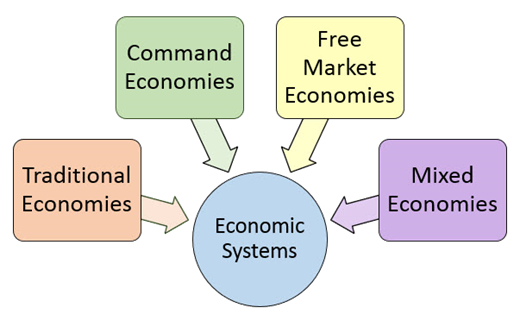
Unit
Overview
Because
a society's survival depends on allocating limited resources to meet people's
needs, it must decide what, how and for whom to produce. Therefore, countries have developed organized
ways to provide for their populations.
This has resulted in specific collections of traditions and rules known
as economic systems. Every society
shapes its economic system based on resources, needs, wants, goals and
values. Although they are described as
traditional, command or market economies, no single, economic system has all
the right answers. For this reason,
nations have adopted features of each of them to form mixed economies. Most countries in the world, however,
emphasize one style more than the others.
Let's see how it all works.
Economic
Systems
Since
resources are always scarce, nations, like individuals, make trade-offs that result in benefits and opportunity cost.
Remember—they must decide what to produce, how to produce and for whom
to produce goods and services based on their available resources and on the
needs of their populations. Every
society determines the answers to these questions according to their own goals and values. Because resources are scarce, countries
establish priorities and often purse some goals at the expense of others. To deal with this process, organized ways to
meet wants and needs on a national scale emerged. These sets of rules are called economic systems, and they fall into
four, broad categories: traditional,
command, market and mixed. Learn more
about economic systems and how they developed by viewing the video listed
below.
![]() Go to Questions 1
and 2.
Go to Questions 1
and 2.
Traditional
Economies
Some
societies rely on customs, rituals and/or habits when they answer the three
basic questions concerning production.
This results in what are known as traditional
economies. They sometimes rely on
barter rather than money and use nearly all that they produce. Little or nothing is left to encourage
trade. Because it is intent on
preserving tradition, this type of economy shows little interest in new ideas
or innovative technology. Generally,
traditional economies are found in rural areas that depend on agriculture
and/or hunting for survival. People are
defined by strict roles, and there is little tolerance for change. Boys usually adopt the same occupations as
their fathers; girls follow the examples established by their mothers. Although some people view this as a
disadvantage, others regard it as a positive aspect of this type of
economy. Everyone knows exactly what is
expected of them. Therefore, there is no
stress over what to produce or how to produce it because every task is
performed just as it always has been.
Without innovation and progress, however, traditional economies result
in a lower standard of living when compared to other economic systems.
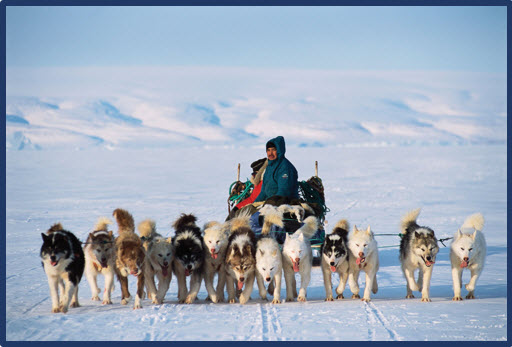
Inuit Hunter with his
Dog Team
Although
examples of traditional economies exist in Africa, Asia and Latin America,
northern Canada, Alaska and Greenland are home to the Inuit people. They have
survived the harsh, Arctic climate for centuries by teaching their children how
to hunt, fish and make tools. These lessons,
along with the custom of sharing with the entire village, are passed from one
generation to the next. Economists and
anthropologists, however, tell us that most traditional economies eventually
evolve into other systems. This usually
occurs through innovation and technology, but, in the case of the Inuit, it is
climate change that appears to have the greatest impact, as the video listed
below explains.
![]() Go to Questions 3 through 6.
Go to Questions 3 through 6.
Command
Economies
In
some societies, the government makes most of the decisions related to the
economy. In this situation, people have
very little input into what, how or for whom goods and services are
produced. This is referred to as a command, or centrally planned, economy. Some of the most famous include the former Soviet Union and the once-communist
bloc countries of Eastern Europe. State Planning Commissions determined needs,
established goals and assigned production quotas for all industries and
farms. The government owned the land and
capital required for production. Planners also controlled the workforce. They could easily shift labor and resources
from the manufacture of consumer goods to the creation of military equipment on
short notice. The Commission also had
the power to set prices and wages.
Today, there are very few economies that operate primarily on this type
of system. In fact, there is no such
thing as a pure command economy.
However, North Korea and Cuba lean heavily in this direction.
Although
a command system does not provide the economic freedom that most people prefer,
it does have certain advantages. Because
a central authority has the power to address economic issues, leaders can
quickly manipulate the factors of production.
For example, the Soviet Union transferred its focus from agricultural
production to heavy industry in just a few decades. Farms were no longer privately owned and were
combined into large collectives controlled by the state. Because the Central Planning Commission
believed that this would increase efficiency, some workers could be reassigned. By shifting workers, land and capital on a
massive scale, the country allocated its resources to achieve its goal of
becoming an international super power.
Soviet leaders expected each citizen, male and female, to contribute by
working in industry, government service or agriculture. In return, he or she received wages set by
the state and public services, such as education and healthcare, at little or
no cost.
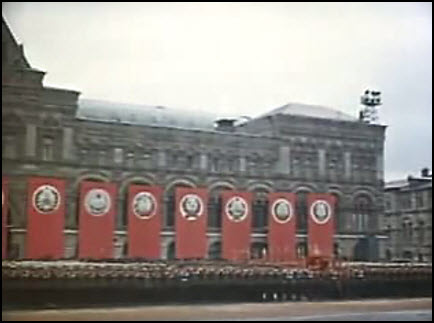
Soviet Military Display: May, 1945
As
with any decision, the choice to operate as a command economy comes with
opportunity cost. By design, the system
places little or no emphasis on consumer goods.
During the Cold War, Soviet citizens found that household appliances,
cars and adequate housing were in short supply because the nation directed its
resources to strengthen its armed forces.
Today, North Koreans face similar shortages as their leaders apply most
of the country's land and capital to the production of military equipment. Since the government owns the factors of
production, laborers have little incentive to work hard. Most factory jobs pay the same, even if they
require special skills or come with added responsibilities. There are few rewards for extra effort or
suggestions for improvements. Workers
are seldom fired for poor performance and, with little to lose, produce
low-quality goods. People generally do
the jobs that they are assigned and give little thought to those that they
might actually like to do. Command
economies do not have the flexibility to deal with minor, day-by-day issues
since even small changes must be approved by the central authority. They also require a large number of
lower-level government officials to enforce quotas and regulations. Although countries continue to experiment
with command economies, most have been unsuccessful and have moved to mixed
economic systems instead.
![]() Go to Questions 7
through 10.
Go to Questions 7
through 10.
Market
Economies
An
economist defines a market as any
arrangement that brings buyers and sellers together to exchange goods or
services. Markets can be local,
regional, national, global and digital.
They come in all shapes, sizes and formats. An outdoor farmer's market, a public auction,
a restaurant, a grocery store, and an art gallery are all defined as markets by
economists. When a society bases its
economy on voluntary buying and selling, it operates as a market, or free market, system and is based on a set of economic
principles called capitalism. In a market economy, individuals and
businesses decide what, how and for whom to produce goods and services. The consumer plays a key role in this system
because producers create goods and services in response to what they are
willing to buy. Some of the most
productive and wealthiest countries in the world operate on a version of the free
market system. The United States, South
Korea and Germany are examples.

Headquarters of Auto Manufacturer BMW: Munich, Germany
Unlike
the command economy, the free market system permits buyers and sellers to
function with a high degree of freedom.
Producers offer whatever goods and services that they believe will sell,
and buyers are free to spend their money as they choose. Opposed to traditional economies in which
people are likely to do the same work as their parents, workers in free market
economies can leave one job to take another.
They can also invest in more education and can train for new
careers. Because they thrive on competition
and consumer participation, market economies function with little government
intervention. Like command economies,
however, totally free market economies do not exist. Governments do step in to address certain
concerns, such as environmental protection, fair competition and safety. An additional benefit of the market economy
is its ability to provide a wide variety of goods and services. It also results in a high level of consumer
satisfaction. Almost everyone can
satisfy his or her wants since meeting the desires of one group does not necessarily
mean that another group will have to sacrifice.
For example, if 40% of the people want cars and 60% want pickup trucks,
both vehicles are likely to be readily available in a market economy.
![]() Free Market vs. Command Economies
Free Market vs. Command Economies
Nonetheless,
the consequences of relying on a market economy are not all positive. Because change is likely to occur at any
time, workers and business owners live with a high level of uncertainty. Markets gradually adjust to these shifts on
their own, but they cause great anxiety in the short term. Companies sometimes move to other locations
to lower production costs. Workers must
then choose between uprooting their families or new employment. Employers are always threatened by the
possibility that another company will manufacture the same goods at a lower
cost. Because businesses constantly
challenge each other, companies that cannot maintain competitive prices lose
customers and, in turn, money. Since
buying and selling drive the economy, some citizens, who are too old or ill to
care for themselves, cannot survive without assistance from government or
private groups. Because businesses
concentrate on offering products that they can sell, the market system does on
its own produce public services, such as national defense or universal
healthcare. Therefore, governments must
cover these costs by collecting taxes.
The balance between government intervention and free exchange varies
from country to country depending on national values and goals.
![]() Go to Questions 11
through 27.
Go to Questions 11
through 27.
Mixed
Economies
All
economic systems have negative consequences.
Traditional economies have limited potential for change or growth. Command economies sacrifice consumer needs
and restrict freedom. Without laws to
ensure fair competition, a few entrepreneurs could easily dominate particular
industries within free market economies.
Because no single economic system is perfect, countries in today's world
rely on a blend of traditional, command and market features to meet their
goals. This results in mixed economies that are mostly
controlled by central planners at one end of the scale and by privately owned
businesses on the opposite side of the spectrum.
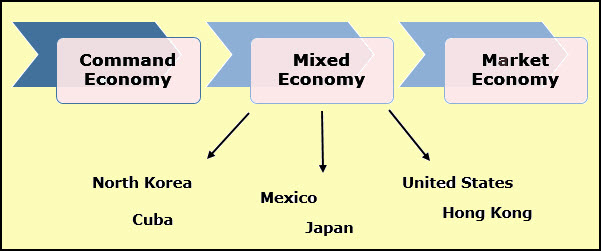
North Korea, for example, has
established an economy that is almost totally controlled by its central
government. In terms of the factors of
production, the government owns all of the land and capital. It also controls the labor. Therefore, industries owned by state produce
95% of the goods and services available to North Koreans. At the same time, the leadership bans almost
all imports from foreign countries.
Although China's economy is
also directed by its government, private citizens own 25% of its industries. In recent decades, the Chinese have relied
less on central planning and more on a free market system. To make this happen, the government privatized, or sold, some industries
and permitted producers to compete in the marketplace. Although these transitions result in positive
change in the long run, they are usually difficult and painful in the short
term.
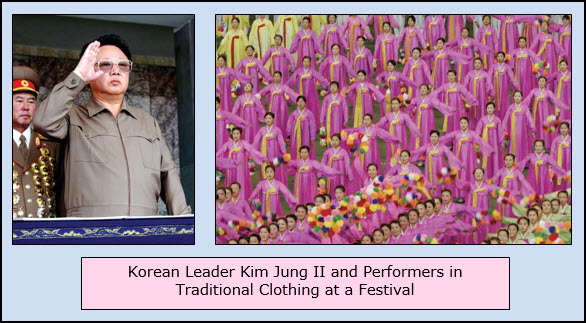
At
the other end of the scale, some economies operate with very little government
intervention. Hong Kong, a former colony of Great Britain, currently functions as
a special administrative region of China.
Here, the private sector drives the economy. There are no barriers to foreign trade, and
banks conduct business independently of the government. Although it protects private property, Hong Kong's
leadership rarely interferes in the free market. However, there are some exceptions. The government does offer some public
services and has established a few limits on prices.
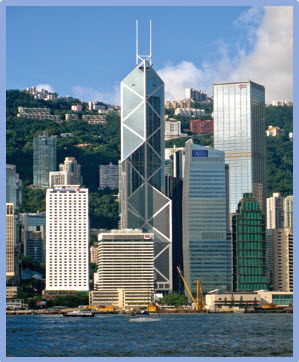
Figure 1Bank
of China Tower: Hong Kong
![]() Go to Questions 28 and 29.
Go to Questions 28 and 29.
Free
Enterprise
Although
not to the same extent as Hong Kong, the United States falls on the market side
of the spectrum. It relies on free
enterprise, a market system with some government intervention and
regulation. Exactly how much government
interference Americans are willing to tolerate has always been a subject for
political debate. The United States is a geographically and
socially diverse country but people do share several, broad economic
goals. Primarily, American citizens
place a high priority on the freedom to
make their own economic decisions.
Businesses
and individuals want to spend their own money as they see fit. They also expect the nation's economic
policies to reflect the traditional values of justice and fairness. For example, Americans sacrifice some of
their economic liberty by accepting laws that forbid employers to discriminate
based on race, religion, age or gender. People also want their economic system
to provide as many jobs as possible. This encourages economic growth and increases
tax revenue for government services.
Americans expect their government to provide a certain amount of protection from changing economic
conditions or catastrophic events.
For this reason, Congress established Social Security to extend
disability and retirement benefits that cover most working people. Over 90% of American workers participate in
the Social Security system.
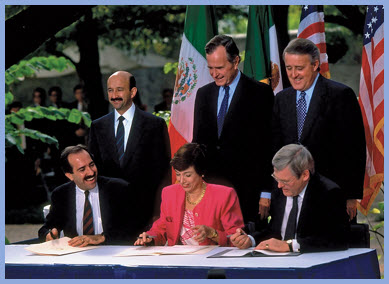
Officials from Canada,
Mexico and the United States Signing NAFTA:
1992
Sharing
common goals does not guarantee agreement on how they are to be achieved. Decisions on economic policy are further
complicated because the goals themselves sometimes contradict each other. This is a direct result of opportunity cost. For example, trade agreements and tariffs may
benefit some industries but cause hardships for others. A law the keeps foreign steel out of the
United States could help to meet the goal of full employment but limit
individual freedom by resulting in fewer choices for consumers. Debates over the minimum wage, universal
healthcare, environmental protection and other issues involve the emphasis of
some goals over others. For the most
part, citizens, companies and the government are able to resolve these
conflicts by making trade-offs. The free
enterprise system is flexible and is able to satisfy most Americans most of the
time.
![]() Go to Questions 30
through 32.
Go to Questions 30
through 32.
What's
next?
In
this unit, you have read about different types of economies and the factors
that influence their decisions concerning what, how and for whom to
produce. Because the United States operates
as a market system, exchanges between buyers and sellers not only determine the
cost of most goods but also the amount of goods that businesses produce. In the following unit, you will examine the
demand side of the marketplace and the economic principles that govern its
impact.
 |
| Unit 3 Main Points Worksheet |
| Unit 3 Comparing economic systems: capitalism, communism and socialism Article and Quiz |
| Unit 3 Inuit |
| Unit 3 Should all high schoolers take courses in personal finance? Worksheet |